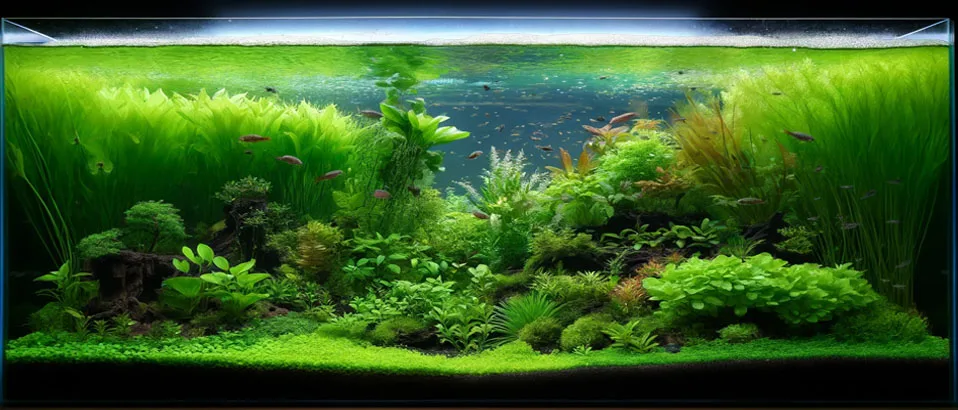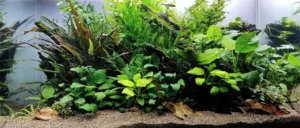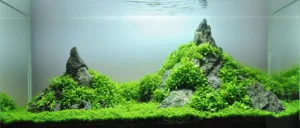Aquarium plants are more than just decorative elements; they play a crucial role in creating a balanced and healthy environment for your aquatic pets. With a myriad of choices available, understanding the different types of aquarium plants can help you make informed decisions for your underwater garden.
Table of Contents
Benefits of Aquarium Plants
Aquarium plants are invaluable for creating a balanced and thriving aquatic environment. They offer a range of benefits that go beyond mere decoration, contributing significantly to the overall health and stability of your aquarium ecosystem.
- Oxygenation: Aquarium plants produce oxygen through photosynthesis, enhancing the oxygen levels in the water and benefiting fish and other aquatic creatures.
- Carbon Dioxide Absorption: They absorb carbon dioxide, helping to maintain stable pH levels and reducing the risk of harmful CO2 buildup.
- Algae Control: By competing with algae for nutrients, aquarium plants help reduce algae growth, keeping the water clear and maintaining a healthy environment.
- Natural Filtration: Plants absorb nitrates, ammonia, and other harmful substances, acting as natural filters and improving water quality.
- Habitat and Shelter: They provide essential hiding spots and habitats for fish, shrimp, and other invertebrates, reducing stress and promoting natural behaviors.
- Aesthetic Appeal: A well-planted aquarium creates a natural and visually pleasing environment, enhancing the beauty of your aquatic setup and providing a calming, serene atmosphere.
- Ecosystem Balance: Aquarium plants support a balanced ecosystem by fostering beneficial bacteria growth and contributing to a stable nitrogen cycle.
By incorporating live plants into your aquarium, you not only enhance its visual appeal but also promote a healthier, more sustainable environment for your aquatic pets.
Types of Aquarium Plants
Floating Aquarium Plants

Floating aquarium plants are unique in that they thrive on the water’s surface, adding a distinct aesthetic and functional layer to your aquarium. They are easy to maintain and provide various benefits such as shading, oxygenation, and nutrient absorption. Here are some common types of floating aquarium plants:
- Duckweed (Lemna minor): Tiny, fast-growing plants that form a dense mat on the water’s surface. They are excellent for nutrient absorption and providing cover for fish.
- Water Lettuce (Pistia stratiotes): With rosette-shaped leaves that float gracefully on the surface, water lettuce is effective at reducing light penetration, which helps control algae growth.
- Frogbit (Limnobium laevigatum): Similar in appearance to water lettuce but smaller, frogbit has attractive, rounded leaves and provides excellent shade and habitat for fish.
- Salvinia (Salvinia natans): This floating fern has small, oval leaves covered with tiny hairs, which help it float. It’s ideal for aquariums with calm water and provides excellent surface coverage.
- Red Root Floater (Phyllanthus fluitans): Known for its striking red roots and green to reddish leaves, this plant adds a splash of color to the water’s surface and thrives in high-light conditions.
- Azolla (Azolla caroliniana): A small, fern-like plant that floats on the water, Azolla is known for its rapid growth and ability to fix nitrogen, improving water quality and providing habitat for small aquatic creatures.
Submerged Aquarium Plants
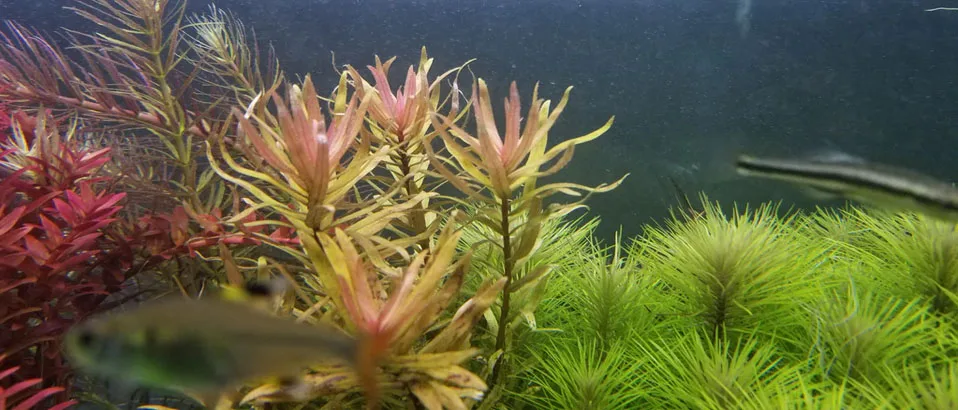
Submerged aquarium plants grow entirely underwater, anchoring their roots in the substrate. These plants play a critical role in oxygenating the water, providing habitats for fish and invertebrates, and maintaining water quality. Here are some popular types of submerged aquarium plants:
- Hornwort (Ceratophyllum demersum): Known for its feathery, bright green leaves, Hornwort is a fast-growing plant that can thrive in various water conditions. It helps in oxygenating the water and offers excellent cover for fish.
- Elodea (Elodea canadensis): This hardy plant is ideal for beginners. It has long, slender leaves and grows quickly, making it effective at absorbing excess nutrients and reducing algae growth.
- Cabomba (Cabomba caroliniana): With its finely divided, fan-like leaves, Cabomba is a beautiful addition to any aquarium. It requires moderate to high light and provides excellent shelter and spawning grounds for fish.
- Anacharis (Egeria densa): Also known as Brazilian Waterweed, Anacharis has thick, bushy foliage that provides a lush background in the aquarium. It’s easy to care for and helps maintain water clarity by absorbing nutrients.
- Vallisneria (Vallisneria spiralis): Vallisneria, or “Vallis,” is known for its long, ribbon-like leaves that create a graceful, flowing effect. It is a hardy plant that can tolerate a wide range of water conditions and helps in oxygenating the tank.
- Java Fern (Microsorum pteropus): Java Fern has tough, dark green leaves and is often attached to rocks or driftwood rather than planted in the substrate. It thrives in low to moderate light and is an excellent choice for beginners.
- Cryptocoryne (Cryptocoryne wendtii): Commonly known as “Crypts,” these plants have broad, wavy leaves and come in various colors. They grow well in low light and are perfect for creating a natural, forest-like appearance.
Emersed Aquarium Plants
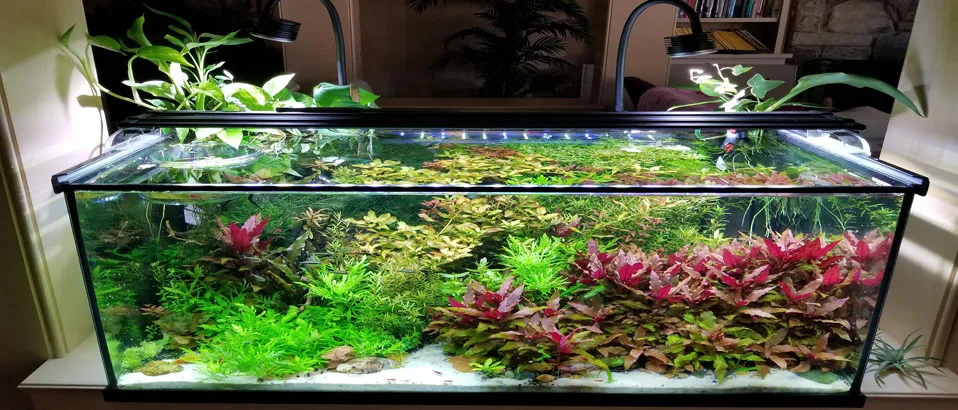
Emersed aquarium plants are unique in that they grow with their roots submerged in water while their leaves and stems extend above the water’s surface. These plants are often used in paludariums and ripariums, creating a striking visual transition between water and air. Here are some common types of emersed aquarium plants:
- Anubias (Anubias barteri): Known for its broad, durable leaves, Anubias can thrive both submerged and emersed. It is a slow-growing plant that does well in low to moderate light and can be attached to rocks or driftwood.
- Sword Plants (Echinodorus species): These plants, with their tall, sword-shaped leaves, are popular in both submerged and emersed forms. They require a nutrient-rich substrate and moderate to high light levels to thrive.
- Peace Lily (Spathiphyllum wallisii): Often used in aquascaping for its striking appearance, the Peace Lily has broad, dark green leaves and can bloom with white flowers. It is a hardy plant that adapts well to emersed growth conditions.
- Umbrella Palm (Cyperus alternifolius): This plant features tall, slender stems topped with umbrella-like clusters of leaves. It is ideal for creating height and texture in paludariums and ripariums.
- Pothos (Epipremnum aureum): While not traditionally an aquatic plant, Pothos can grow emersed with its roots in water. Its trailing vines and heart-shaped leaves make it a popular choice for filtering water and adding greenery.
- Syngonium (Syngonium podophyllum): Also known as Arrowhead Plant, Syngonium has arrow-shaped leaves and can grow both emersed and as a terrestrial plant. It is easy to care for and adapts well to various light conditions.
- Lucky Bamboo (Dracaena sanderiana): Often seen in aquascapes, Lucky Bamboo is not true bamboo but thrives in water with its roots submerged and stems emersed. It adds an elegant, vertical element to the setup.
Carpet Aquarium Plants
Carpet aquarium plants are highly sought after for their ability to create a lush, green carpet over the substrate, giving the aquarium a natural and aesthetically pleasing look. These plants grow low and spread horizontally, covering the bottom of the tank. Here are some popular types of carpet aquarium plants:
- Dwarf Hairgrass (Eleocharis acicularis): This plant features fine, grass-like leaves that form a dense carpet. It grows quickly under high light conditions and with adequate CO2 supplementation, making it a favorite among aquascapers.
- Glossostigma (Glossostigma elatinoides): Known for its small, round leaves, Glossostigma spreads rapidly and creates a bright green carpet. It requires high light and CO2 levels to thrive, making it suitable for experienced aquarists.
- Monte Carlo (Micranthemum tweediei): Monte Carlo is a versatile carpet plant with small, round leaves that grow densely. It can thrive in moderate to high light conditions and is less demanding than some other carpeting plants, making it a good choice for beginners.
- Marsilea (Marsilea hirsuta): Marsilea, also known as Water Clover, has clover-like leaves that can grow submerged or emersed. It is a hardy plant that can adapt to various light conditions and forms a beautiful, low-growing carpet.
- Baby Tears (Hemianthus callitrichoides): Often called “HC,” Baby Tears have tiny leaves that create a delicate, vibrant green carpet. This plant requires high light and CO2 levels to flourish and is popular in aquascaping for its fine texture.
- Staurogyne Repens (Staurogyne repens): With its small, green leaves and compact growth habit, Staurogyne Repens is an excellent choice for carpeting the foreground of an aquarium. It is relatively easy to care for and thrives in moderate light.
- Utricularia Graminifolia: This unique carnivorous plant has grass-like leaves and forms a dense carpet. It requires high light and CO2 levels and can add an interesting element to the aquarium with its tiny, bladder-like traps.
Common Types of Aquarium Plants
Aquarium plants come in a variety of shapes, sizes, and colors, each offering unique benefits and aesthetic appeal. Here are some of the most common types of aquarium plants that are loved by aquarists for their beauty, ease of care, and functionality:
- Java Moss (Taxiphyllum barbieri): Java Moss is a versatile and hardy plant that can be attached to rocks, driftwood, or left to float freely. It’s ideal for beginners due to its low maintenance and adaptability to various water conditions. Java Moss provides excellent cover for fish and shrimp and is often used in breeding tanks.
- Amazon Sword (Echinodorus amazonicus): Amazon Sword is a popular choice for larger aquariums. Its broad, sword-like leaves create a striking focal point and offer excellent cover for fish. This plant thrives in nutrient-rich substrates and moderate to high lighting conditions.
- Anubias (Anubias barteri): Known for its durability and low light requirements, Anubias has broad, dark green leaves that add a touch of elegance to any aquarium. It grows slowly and is typically attached to hardscape elements like rocks or driftwood rather than planted in the substrate.
- Water Wisteria (Hygrophila difformis): Water Wisteria is a fast-growing plant that helps prevent algae by absorbing excess nutrients. Its finely divided leaves provide excellent cover for fish and can be used as both a foreground and background plant depending on trimming.
- Cryptocoryne Wendtii (Cryptocoryne wendtii): Commonly known as “Crypts,” these plants have broad, wavy leaves and come in various colors from green to brown and red. They grow well in low light and are perfect for creating a natural, forest-like appearance in the aquarium.
- Java Fern (Microsorum pteropus): Java Fern has tough, dark green leaves and is often attached to rocks or driftwood. It thrives in low to moderate light and is an excellent choice for beginners due to its low maintenance requirements.
- Dwarf Baby Tears (Hemianthus callitrichoides): Often called “HC,” Dwarf Baby Tears have tiny leaves that create a dense, vibrant green carpet. This plant requires high light and CO2 levels to flourish and is popular in aquascaping for its fine texture and beautiful appearance.
These common aquarium plant species are not only visually appealing but also contribute to a healthy and balanced aquatic environment. Whether you’re looking to create a lush, green carpet, a dramatic focal point, or a naturalistic aquascape, these plants offer a range of options to suit any aquarium setup.
Choosing the Right Plants for Your Aquarium
Selecting the appropriate plants for your aquarium is crucial for creating a thriving and visually appealing aquatic environment. The right plants not only enhance the beauty of your tank but also support the health and well-being of your aquatic pets. Here are some key considerations to help you choose the best plants for your aquarium:
- Tank Size and Layout: The size and layout of your aquarium play a significant role in plant selection. Larger tanks can accommodate taller and more robust plants like Amazon Swords, while smaller tanks might benefit from compact species such as Anubias or carpet plants like Dwarf Hairgrass.
- Lighting Conditions: Different plants have varying light requirements. High-light plants like Baby Tears and Glossostigma need intense illumination, while low-light plants like Java Fern and Anubias can thrive in dimmer conditions. Ensure your lighting setup matches the needs of the plants you choose.
- Substrate Type: The substrate is crucial for rooting plants and providing them with nutrients. Plants like Cryptocoryne and Vallisneria require nutrient-rich substrates, while others like Java Moss and Anubias can be attached to rocks or driftwood.
- Water Parameters: Consider the water parameters, such as pH, hardness, and temperature, when selecting plants. Some species, like Amazon Sword, prefer softer, slightly acidic water, while others, like Hornwort, are more adaptable to a range of conditions.
- Compatibility with Fish: Ensure the plants you choose are compatible with your fish species. Some fish, like goldfish, tend to uproot or eat certain plants, so selecting hardy species like Java Fern or Anubias can prevent issues.
- Maintenance Level: Your availability and willingness to perform maintenance should influence your plant choices. Fast-growing plants like Water Wisteria and Cabomba may require frequent trimming, while slow-growing plants like Anubias and Java Fern are more low-maintenance.
- Aesthetic Goals: Consider the overall look you want to achieve in your aquarium. Carpet plants can create a lush, green floor, while tall plants add height and grace. Mixing different types of plants can create a balanced and natural appearance.
Plant Care and Maintenance
Proper care and maintenance are essential for keeping your aquarium plants healthy and vibrant. Here are some key aspects to consider for effective plant care:
- Lighting: Ensure that your plants receive the appropriate amount of light. High-light plants may need intense lighting for several hours a day, while low-light plants can thrive under moderate illumination. Use a timer to maintain a consistent lighting schedule.
- Nutrients and Fertilizers: Aquarium plants require essential nutrients, including nitrogen, phosphorus, potassium, and trace elements. Use root tabs for substrate-rooted plants and liquid fertilizers for water column feeders. Monitor nutrient levels and adjust fertilization as needed.
- CO2 Supplementation: Carbon dioxide is vital for photosynthesis, especially in high-light tanks. CO2 supplementation can significantly enhance plant growth and health. You can use a CO2 injection system or liquid carbon supplements to provide the necessary CO2.
- Water Parameters: Maintain stable water parameters that suit your plants. Regularly test for pH, hardness, and nutrient levels. Most plants prefer a pH range of 6.5 to 7.5 and moderate water hardness. Perform regular water changes to keep the water clean and nutrient levels balanced.
- Trimming and Pruning: Regular trimming helps maintain the shape and size of your plants and encourages new growth. Remove dead or decaying leaves to prevent them from decomposing and affecting water quality. Pruning can also help control the spread of fast-growing species.
- Algae Control: Algae can compete with plants for nutrients and light. To control algae growth, maintain a balance between lighting, nutrients, and CO2. Introduce algae-eating fish or invertebrates, like Amano shrimp or Otocinclus catfish, to help keep algae in check.
- Pest Management: Inspect new plants for pests like snails or algae before introducing them to your tank. Quarantine new plants if necessary. If pests appear, manual removal or introducing natural predators can help manage the problem.
- Substrate Maintenance: For substrate-rooted plants, regularly stir the substrate to prevent compacting and ensure proper root aeration. Add root tabs periodically to replenish nutrients.
- Plant Rotation: Occasionally rotate plants within the tank to ensure even light distribution and prevent some plants from overshadowing others. This practice can help maintain a balanced and attractive aquascape.
By following these care and maintenance tips, you can create a healthy, thriving aquatic environment that showcases the beauty of your aquarium plants. Consistent attention to lighting, nutrients, and overall tank conditions will ensure your plants remain vibrant and enhance the overall aesthetic of your aquarium.
Conclusion
Aquarium plants are an integral part of creating a balanced and beautiful aquatic environment. They offer numerous benefits, from oxygenation and natural filtration to providing habitats and enhancing the visual appeal of your tank. Understanding the different types of aquarium plants—floating, submerged, emersed, and carpet—helps in making informed decisions that suit your aquarium’s specific needs.
Popular species like Java Moss, Amazon Sword, Anubias, and Water Wisteria are beloved for their ease of care and aesthetic contributions. Choosing the right plants involves considering factors such as tank size, lighting, substrate, water parameters, and compatibility with your fish.
Proper care and maintenance are crucial for keeping your plants healthy and vibrant. Consistent lighting, nutrient management, CO2 supplementation, and regular trimming are key practices to ensure a thriving plant environment. Addressing algae control, pest management, and substrate maintenance further supports the well-being of your aquatic flora.
By carefully selecting and tending to your aquarium plants, you can create a stunning underwater garden that not only beautifies your space but also fosters a healthy and balanced ecosystem for your aquatic pets. Whether you’re a beginner or an experienced aquarist, incorporating a variety of plants will elevate your aquarium to new heights of beauty and functionality.
Your Frequently Asked Questions
Q1: What type of light do aquarium plants need?
Aquarium plants need lighting that matches their specific requirements. High-light plants need intense, full-spectrum lighting for several hours a day, while low-light plants can thrive under moderate illumination. LED lights designed for aquariums are a popular choice due to their efficiency and ability to provide the necessary spectrum.
Q2: What type of substrate is best for aquarium plants?
The best substrate for aquarium plants is nutrient-rich and can support root growth. Options include specialized planted aquarium substrates, such as those made from clay or volcanic soil, which provide essential nutrients. Regular aquarium gravel can be used but may require additional root tabs or fertilization.
Q3: What type of filter is best for a planted aquarium?
A filter that provides gentle water flow and does not disturb the substrate is ideal for a planted aquarium. Canister filters are a popular choice because they offer customizable flow rates and efficient filtration. Sponge filters are also suitable for smaller tanks and provide biological filtration without strong currents.
Q4: What type of aquarium plants can I attach to rocks?
Plants that can be attached to rocks include Java Moss (Taxiphyllum barbieri), Anubias (Anubias barteri), and Java Fern (Microsorum pteropus). These plants have rhizomes that can be tied or glued to rocks, allowing them to anchor and grow effectively without being planted in the substrate.
Q5: What are the benefits of having live plants in my aquarium?
Live aquarium plants provide numerous benefits, including oxygenation, carbon dioxide absorption, algae control, natural filtration, and habitats for fish. They also enhance the aesthetic appeal of your tank and contribute to a balanced ecosystem.
Q6: What are some common types of floating aquarium plants?
Common types of floating aquarium plants include Duckweed (Lemna minor), Water Lettuce (Pistia stratiotes), Frogbit (Limnobium laevigatum), Salvinia (Salvinia natans), Red Root Floater (Phyllanthus fluitans), and Azolla (Azolla caroliniana).
Q7: What are the best submerged plants for beginners?
Some of the best submerged plants for beginners are Hornwort (Ceratophyllum demersum), Elodea (Elodea canadensis), Anacharis (Egeria densa), and Java Fern (Microsorum pteropus). These plants are hardy, easy to care for, and adaptable to various water conditions.
Q8: Can I grow plants that extend above the water’s surface in my aquarium?
Yes, emersed plants such as Anubias (Anubias barteri), Sword Plants (Echinodorus species), Peace Lily (Spathiphyllum wallisii), and Lucky Bamboo (Dracaena sanderiana) grow with their roots submerged and their leaves and stems above the water’s surface.
Q9: What are carpet plants and why are they popular in aquascaping?
Carpet plants, like Dwarf Hairgrass (Eleocharis acicularis), Glossostigma (Glossostigma elatinoides), Monte Carlo (Micranthemum tweediei), and Dwarf Baby Tears (Hemianthus callitrichoides), form a lush, green carpet over the substrate. They are popular in aquascaping for their ability to create a natural and visually appealing ground cover.
Q10: How do I choose the right plants for my aquarium?
To choose the right plants, consider your tank size, lighting conditions, substrate type, water parameters, and compatibility with your fish. Additionally, think about your maintenance capabilities and aesthetic goals to ensure the plants suit your setup and preferences.
Q11: What are some popular aquarium plant species?
Popular aquarium plant species include Java Moss (Taxiphyllum barbieri), Amazon Sword (Echinodorus amazonicus), Anubias (Anubias barteri), Water Wisteria (Hygrophila difformis), and Cryptocoryne Wendtii (Cryptocoryne wendtii). These plants are favored for their beauty, ease of care, and functionality in the aquarium.
Q12: How do I care for and maintain my aquarium plants?
Caring for aquarium plants involves providing adequate lighting, nutrients, and CO2 supplementation. Regularly trim and prune plants, monitor water parameters, control algae, manage pests, and maintain the substrate. Consistent care will ensure healthy and vibrant plant growth.
Q13: Do aquarium plants need CO2 supplementation?
While not all aquarium plants require CO2 supplementation, high-light plants and densely planted tanks can benefit significantly from added CO2. It enhances plant growth and health, especially in tanks with intense lighting.
Q14: How can I control algae in a planted aquarium?
To control algae, maintain a balance between lighting, nutrients, and CO2. Regular water changes, proper fertilization, and introducing algae-eating fish or invertebrates like Amano shrimp or Otocinclus catfish can help keep algae in check.

